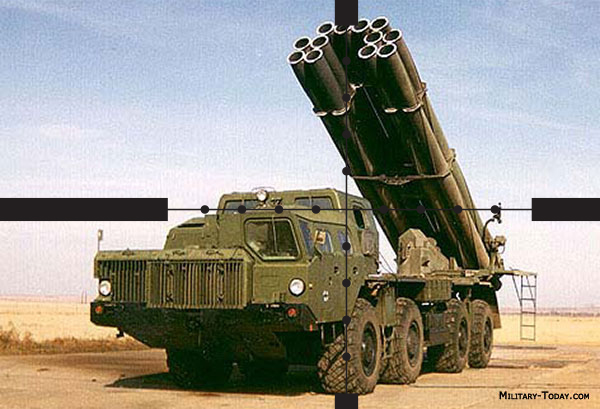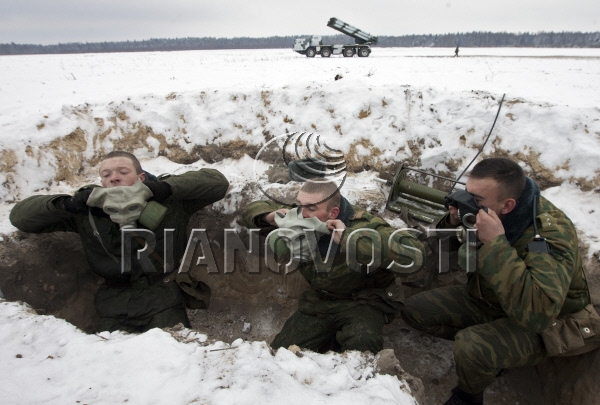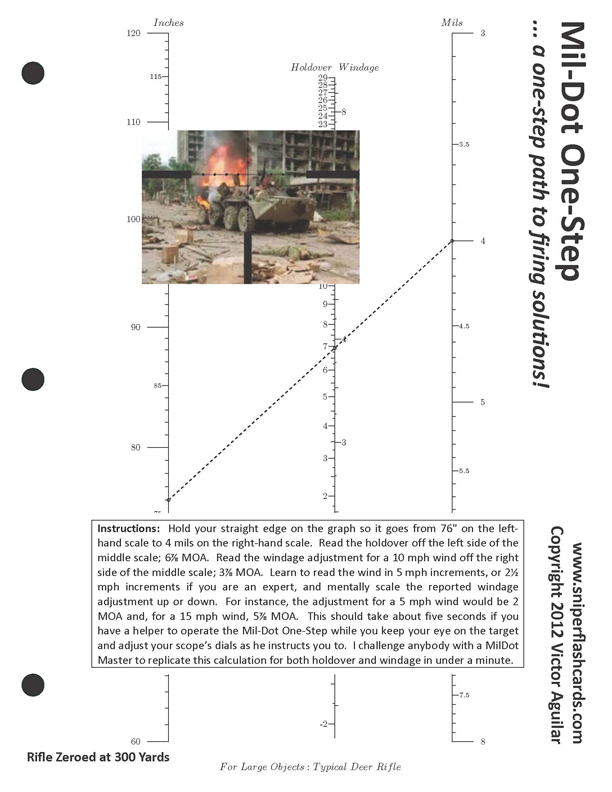
The Red Army is massing on the border of your country. Your hometown, only twenty-five miles from Russia, is directly in their path should they invade. Armed with a deer rifle zeroed at 300 yards, you and your partner are fifteen miles inside Russia, doing reconnaissance, when you spot a MAZ-543 truck with a BM-30 Smirch mounted on it, accompanied by a T-90 tank. To your horror, the crew positions the vehicle to face your hometown and raises the launch tubes!
The Smirch has twice the range of the U.S. MLRS. Each of its twelve rockets deliver 72 two-kilo bomblets which fall straight down, unlike the U.S. rockets that contain a single bomb that approaches at 30° and can be deflected by concrete walls. Anti-armor bomblets can punch through the top of a Bradley, or they may have anti-personnel or incendiary bomblets.
Knowing that the T-90 has night vision, you dare not turn on your laser rangefinder. Instead, you observe the distance from the ground to the top of the driver’s compartment, which you know to be 116 inches, and find that it measures five mils in your mil-dot scope. (The same truck with a SCUD has a different passenger compartment, so always measure to the top of the driver’s compartment.) By observing the movement of the grass and the tree leaves, you conclude that there is a fifteen mile-per-hour crosswind.

It has taken you five seconds to make these observations. If you had a Mil-Dot One-Step, it would take your spotter another five seconds to calculate the holdover and windage to within the nearest eighth MOA, five seconds for you to reach up and twist the dials of your scope, and then you can shoot the three crew members who have taken cover in a ditch to avoid the rocket’s exhaust.
But let us assume that you have stupidly purchased a Mildot Master instead. What is the correct holdover and windage? Contact me with your answer and tell me how many seconds it took you to find the solution with your Mildot Master. If it does not appear that a Mildot Master is capable of this simple and entirely realistic calculation, then contact Bruce Robinson and ask him to explain how to use his slide rule for this purpose. If he cannot tell you, then throw it in the trash and buy a Mil-Dot One-Step.

This graphic shows the Mil-Dot One-Step being used to fire on a BTR-80. As you can see, it is simply a matter of holding a straight edge across the graph from the scale for inches to the scale for mils and then reading holdover and windage off the center scale; faster than a pocket calculator! The picture of the BTR-80 in the illustration covers the part of the graph you would use for the MAZ-543 but, if you can correctly answer the question anyway, I will send you a free set of wallet-sized cards and rifle-stock stickers, an $8.00 value!
Note that, in this example, I used the Mil-Dot One-Step for a typical deer rifle in Metro atmospheric conditions. However, I can produce Mil-Dot One-Steps for any weapon at any altitude and temperature – even the heavy machine guns and cannons being used in Kashmir. Just let me know what weapon you have been issued and the altitude and temperature of your area of operation and I will produce a Mil-Dot One-Step for you.
The Mil-Dot One-Step shown is for small arms, but I also have larger Mil-Dot One-Steps for powerful weapons like the .338 Lapua that have holdover and windage information out to 2500 yards. The .338 Lapua can directly target a SCUD missile (they do not fly too well with bullet holes in them, as Saddam Hussein learned to his chagrin) so, for instance, if the driver’s compartment of the MAZ-543 measures 1.5 mils, it would take you five seconds to learn that the holdover, with a 1000-yard zero, is 80 MOA and that you need 14.25 MOA windage for a 10 mph crosswind. I challenge you to obtain this information for the .338 Lapua in five or even 500 seconds with the Mildot Master.
